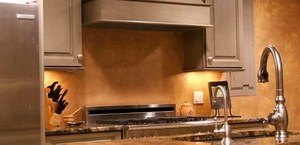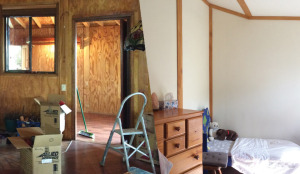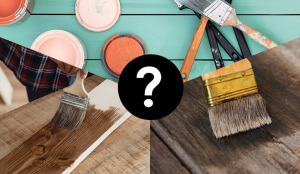Do your walls need a coat of paint, but you have no idea where to start? In this complete beginners DIY guide we explain how to prepare and paint interior of home, step-by-step.
Perhaps you’ve just moved into a new place, or your existing paint could do with a freshen up or new color.
Painting your house interior may seem like a daunting task if you’re never done it before. But with a bit of planning and guidance from us, you will come to see that it is not that difficult, and can even be fun.

Compared with hiring a professional painter, a DIY house paint job will not cost you a lot of money, but it will add value to your home. Not to mention, a new paint job will make your home more comfortable and presentable when you have guests around. Painting your indoors should be enjoyable and creative, a canvas to express your personality and taste.
It is possible to paint your house or apartment to perfection if you follow the right steps. Here are the steps…
Checklist – Paint Interior of Home
Here is a quick checklist of the steps we are going to cover to paint the interior of your home. Scroll down for more instructions on each step.
PART 1: Preparation
- Choose a Painting Date
- Choose a date when you can paint undisturbed
- Make plans to vacate the room afterwards
- Purchase Your Paint, Primer and Painting Tools
- Tidy Room and Remove Items
- Take furniture out (where possible)
- Remove appliances and electronics
- Remove ornaments and wall hangings
- Remove soft furnishings
- Vacuum floor and remove cobwebs
- Wash and Inspect the Walls
- Lay Down Drop Cloths
- Setup Ventilation
PART 2: Painting
- Prime the Walls
- Paint Ceiling with Roller
- Paint Trims with Brush
- Paint Walls with Roller
- Paint Wall Edges with Brush
- Sand the Walls Lightly
- Repeat Painting the Walls and Edges
- Clean Up, Vacate Room and Allow to Dry
Preparation to Paint Interior of Home
1// Choose a Painting Date
It is important to carefully consider and choose a painting date for several reasons. This allows you to set a goal for having all your painting equipment and paints purchased, and having your room cleaned up and ready to go. It also ensures you can make plans to paint undisturbed, vacate the room once you have finished painting, and maybe invite a friend over to help you paint.
Choose a date when you can paint undisturbed
If this is your first time painting a room by yourself, set aside a whole day when you can paint undisturbed. By planning and setting aside time to paint, it will be easy to avoid stress caused by interruptions. On the other hand, if you allow yourself to be distracted by family, friends or other tasks, then you are less likely to finish your room painting by the end of the day.
If you have a young family, make plans to take your kids to a family or friends place for the day so they aren’t under your feet. From personal experience, I can tell you that despite all the cute pictures of toddlers helping out with painting, the reality is that having young kids around while painting your house will leave you ripping your hair out and probably create a huge mess.
Make plans to vacate the room afterwards
This is an easily overlooked point, but an important one. When you choose a date to paint your home interior, make a plan to stay somewhere else that night. Even with good ventilation the paint fumes will linger, sometimes for days. For their personal safety, you want to keep family members away from the fumes released by the paint.
When I was painting our home interior, I planned my painting days around family trips; I would paint a room the day before going on a weekend trip away. If you can’t leave the house, ensure you look for an alternate room where the family members will stay till the room has dried up completely before they move back into the room.
As well as the safety and comfort factor, the wet paint applied on the walls should be left undisturbed. To prevent people from accidentally bumping the wet paint, you should have measures in place to vacate the room after painting is finished.
2// Purchase Your Paint, Primer and Painting Tools
You will need a few tools to paint the house such as a roller and paintbrushes, as well as primer and paint in the colors you want. Make sure to buy your equipment, primer and paint well in advance, just in case the store doesn’t have the things you need in stock. It goes without saying that you should have chosen your paint colors already – if not, then definitely do that first!
For a full equipment list, go down to the Painting Tools section of this article.
3// Tidy Room and Remove Items
Take furniture out (where possible)
It is easier to paint interior of home when it is empty, and removing furniture will avoid any incident where paint could fall on the furniture. Try to remove as much furniture as possible from the room. This will also allow you space to move around freely as you paint the room interior walls. Otherwise, the upholstery on your furniture can catch paint, and it will be a headache to remove it. To avoid this trouble, get a separate room where you can move all the furniture before the paintwork begins.
Remove appliances and electronics
All appliances and electronics should be removed from the room. Some of the items you should remove include the TV and the light fittings, as you might bump them with your roller especially as a beginner. It will be a big step towards freeing up the room so that you can start the paintwork.
Remove ornaments and wall hangings
You may have ornaments, photos and wall hangings in your room. You need to remove them before you start the cleaning process. Get a box where you can place all the ornaments to keep them together, and make it easy to put them back up when you’re finished.
Remove soft furnishings
If you have rugs and curtains in the room, you will need to remove them so that they do not catch the paint. Soft furnishings can be very difficult to clean if they develop paint marks, so it is worth taking the time to remove them.
Vacuum floor and remove cobwebs
You don’t want dust floating around and getting caught in your paint while you are painting the baseboards or walls. Likewise, you don’t want cobwebs to get stuck in your roller while you are trying to paint the ceiling. Make sure the room is nice and clean to avoid such issues.
4// Wash and Inspect the Walls
The next step you need to take in your house painting preparation involves washing the walls, to remove all foreign particles that may have developed on the wall. If your wall is in good condition, this is pretty straightforward.
This is also a good time to inspect the health of your walls, for anything you might need to fix before priming and painting. Things to look out for:
- Water damage and leaks. If your wall was affected by moisture, you may need to fix any moisture damage on the wall first and ensure it is dry. If there are any leaks that are continuing to damage your wall, you should get that fixed first.
- Mold and mildew. You will need to remove mold and mildew from your walls before you start the paint job. You can buy specialty mold removers from any hardware store, just follow the instructions on the pack.
- Holes, chips and cracks. You can patch up any small gouges, minor cracks or imperfections with filler (spackle). Doing so is fairly easy. You will need to buy some spackling paste and a spatula, and allow time for it to dry. If you have any major cracks, you should make sure there are no serious structural issues with your house that need to be looked at.
To clean the walls, use water and mild detergent applied with a cloth or sponge, wiping and rubbing gently to remove any debris that may have been deposited on the walls. Pay attention to areas where stains have developed and make sure to remove all grease from the wall, especially if you are working in the kitchen. By washing dirt and grease off the walls, the paint and primer will adhere better to the wall. Don’t use too much water, and make sure it is fully dry before you start painting.
5// Lay Down Drop Cloths
Put drop cloths on the floor, to protect your floor from paint drips. Tape down the drop cloths or weigh them down with bricks, to prevent the cloths moving out of place as you walk around painting.
If you have furniture in your home that you can’t take out of the room (eg bed, lounge), you need to protect them before starting the paintwork as well, which you can do by draping them with drop cloths. If there are any small fixtures you need to protect, such as power points or window sills, you can cover them with masking tape.
6// Setup Ventilation
Priming and painting is going to create some unpleasant fumes. Make sure you have some ventilation set-up, such as a pedestal fan as well as an open window or door. Ideally, have several windows open plus a fan, and take regular breaks during painting to get some fresh air.
Ok, your preparation is now done. Next, we get to the fun bit – painting.
Steps on How to Paint a Room Interior
1// Prime the Walls
The first step you should take in your paint job is to prime the walls. The base coat makes it easy to apply the topcoat. It has adhesive features that make it very reliable when applying a top coat of paint. There are several primers in the market, and for a regular room we suggest water-based primer, unless you are painting wood (if you are painting wood, then use oil-based instead). Use a roller as per the painting instructions below, and stick to the instructions on the can with regard to drying times.
Tips to prime walls:
- Use a different roller and tray to the one you will use for painting. This way you don’t have to mess around with cleaning the primer off your rolling tools before painting.
- Have a clean rag and a small cup of water nearby to quickly wipe away any small drips or spills before they dry. If you are using oil-based primer, then instead of water have a small cup of turps and a rag nearby.
2// Paint Ceiling with Roller – How To…
Do you paint the wall or ceiling first?
You should start by painting the ceiling first.
The reason is simple – painting the ceiling first will avoid a situation where ceiling paint could spray or drip onto the walls. For example, if you apply paint to the walls first, there is a risk of paint from the ceiling getting onto your freshly painted walls. If you paint the ceiling first, this isn’t going to happen.
How paint ceiling with roller:
You will need a flat paint sheen to paint the ceiling using a roller. You can get ceiling paint and primer combined, which is useful so you don’t have the apply a coat of primer underneath. A thick roller nap is required to achieve the best results as you paint the ceiling.
When you apply paint on your ceiling, ensure you don’t put too much paint on the roller to achieve the best results. If you make a mistake, rolling in the opposite direction will clear the marks on the ceiling. If your painting appears uneven or rough, apply another coat of paint to hide any roller marks.
Alternatively, you can spray the ceiling with a paint sprayer to avoid developing roller marks.
Allow to dry according to the paint tin directions, then apply another coat.
3// Paint Trims with Brush – How To…
Do you paint the walls or trim first?
This is debatable, but we lean towards painting the trim first.
Professional painters prefer painting the trim first because it is easy to cover small areas when you apply paint to the rest of the walls. On the other hand, if you have trims where wall paint could drip on them, then you might prefer to paint the walls before trims for the same reason that you would paint the ceiling before walls.
Tips to paint trim:
- When painting the trims, you need to use a small paintbrush. A roller is generally not a great choice here, as the trim tends to have hidden spaces that the roller can hardly reach.
- Apply 2 coats of paint, but read the paint can for recommendations.
- If you are careful, you can proceed to painting the walls while the trim paint is drying. Or maybe this is a good time to take a lunch break!
How to paint baseboards:
Apply primer before you proceed to painting. Next, you should start painting the baseboards from the corner. Use a one-foot section procedure to reach different sections of the baseboard. That is, work along the length one-foot at a time. Apply strokes in a single direction rather than brushing back and forth.
4// Paint Walls with Roller – How To..
Tips to paint a room with roller:
To achieve the best results when painting the wall with roller, you need to use little paint. If the roller is saturated with paint, it leaves roller marks on the walls. Try to use less paint on the roller so that all the paint applied on the walls will sit on the wall easily. When applying the roller, ensure you apply for several passes until the roller marks disappear.
Apply just one coat of paint for now, then proceed to the next step (painting edges).
View the following video to understand the paint roller technique, before trying to paint the wall with roller yourself.
How paint wall with roller video:
Here’s a great beginners video to paint interior of home with roller, to show you how it’s done. Video produced and shared by ‘Home RenoVision DIY’ on YouTube – thanks guys!
5// Paint Wall Edges with Brush – How To…
You will be required to use a paintbrush to paint the edges. In most cases, the roller will not fit in the edges. This job will be easier if you get yourself a good quality angled paintbrush – for tips on buying a paintbrush, visit our paintbrushes article here. The process is easy to accomplish if you can utilize the right tools.
Use a paintbrush to apply paint to the edges, then allow the wall paint and edges to dry. Once dried as per the paint can recommendations, you can then apply another coat of paint to the rest of the walls.
6// Sand the Walls Lightly
Using fine-grit sandpaper and a sander, lightly sand the wall between coats. This will ensure a smoother finish. Once you have finished sanding, wipe the walls with a rag to remove all dust, before applying the next coat of paint.
7// Repeat Painting the Walls and Edges
Following Step 4 apply another coat of paint to the walls, then following Step 5 apply another coat to the wall edges. Then allow it to dry.
Assess whether it needs another coat of paint, using your own eyes to determine whether it looks patchy or good. Try to observe it in different light, sometimes painting imperfections will show in some lighting situations and not others.
If you feel it needs another coat, then repeat Steps 4-5 once again to finish painting the interior of your home.
8// Clean Up, Vacate Room and Allow to Dry
This step is pretty self-explanatory. After you paint interior of home, simply clean up and clear the room. Open a window and leave a fan in the room to help it dry quicker, and to clear the fumes out faster. If it’s a bedroom, be prepared to sleep somewhere else that night.
9// Paint Interior of Home Done!
Nice work! You did it. Now time to move all your furniture and things back into place, and put everything away.
Required Equipment to Paint Interior of Home
To paint your home effectively and efficiently, you need to have the right tools. There are several pieces of equipment you will need to paint the home’s interior. In this case we are working with the idea that you will be using a paint roller, since that is the most common way to paint interior of home for most people. Shop around to ensure you get high-quality equipment that will make it easy to keep the interior of your home clean. Cheap equipment is more likely to lead to mistakes such as drips and spillages, so it is worth spending a little extra on good gear. Some of the items you will need to paint the interior of your house or apartment are:
Brushes
Look for high-quality brushes that will spread the paint evenly. Different types of paint will require specific types of paintbrushes. Check out the brush description to ensure it is suitable for a given paint job before buying. In most cases, you will realize some brushes are specifically sized and shaped for certain applications, and there is a great variance in quality. Check out our article here for paintbrush buying tips.
Tip:
- Look for brushes with tightly bundled bristles, with no loose fly-aways. Loose hairs easily pick up paint that will drag untidily along your surface.
- If you bought a brush with loose hairs sticking out the sides, just snip them off with scissors (a simple but very handy tip I learnt in art school).
Roller Frames, Covers, Trays and Poles
You will also require roller frames, covers, trays and poles. Roller covers come in a variety of styles, simply look at the package to find it’s suitability for different projects. The packaging is usually quite clear in stating whether they are more suitable for ceilings, walls, oil-based or water-based etc. You can usually buy a kit that contains the roller frame, tray and cover – all you need to get is a pole to attach to it. Usually a standard screw-in broom handle will fit the roller, but check to be sure. Buy a few, so you can have separate rollers for primer, ceiling paint and wall paint in various colors; this will save you from having to clean up rollers while in the middle of painting.
With regard to price and quality, I usually go for something in the middle. The reason is because I personally don’t bother to wash the roller covers afterwards; I just throw them in the trash. I know it is a bit wasteful and yes I do feel a little guilty for it, but paint rollers are a huge headache to clean, and in most cases you paint the walls so rarely that you can justify tossing them in the bin afterwards. The medium-priced roller covers are affordable enough that you can throw them out after painting, while still getting a nice finish on your walls.
Masking Tape
There are some surfaces where you do not want paint to touch such as trims and the edges of the floor, and for these you will require masking tape to cover them. Buy a masking tape that will be strong enough to hold the materials in place so the paint wont penetrate. When you get high-quality tapes, they will work perfectly to get the best cover possible. Some cheap masking tapes will lift up at the edges allowing paint to seep underneath, so it is worth spending a bit extra on good quality tape.
Sandpaper and Sander
You need to apply sandpaper to remove imperfections from the wall before you can paint it, as well as between coats. Get high-quality fine-grit sandpaper. Sanding will play a great role in achieving the best results and a nice smooth finish. Depending on the size of the area you are sanding, you might want to get a lightweight electric sander, because sanding by hand with a block can become very tiring very quickly. You can pick up a suitable sander for less than $100, and it will come in handy for all sorts of other DIY jobs too.
Drop Cloths and Plastic Sheeting
You will need plastic sheets or cloths to cover areas where you don’t want paint to go, such as the floor, TV and lounges. For example, if you would not like paint to land on the baseboards, you will use drop cloths to cover it while painting. Get enough plastic sheets or drop cloths to cover all the areas you need. Hold the sheets or cloths down with masking tape or bricks, to prevent them sliding around. I personally prefer fabric drop cloths, because they are easy to scrunch up and toss in a bag if you happen to get paint on them, whereas plastic sheets are less maneuverable in this regard. You can buy drop cloths for cheap, but I just use old bed sheets and I’ve never had a problem with seepage; if doing this just make sure they aren’t too thin so paint wont seep through in case you happen to spill some.
Caulks, Sealants, Spackle and Tools
Some sections in the wall may have cracks, holes or gaps. You need to seal all the cracks and holes before applying paint. Use caulks and sealants to seal larger gaps before you start applying paint, especially in those gaps between trims and walls, or around power points and other fittings. Use spackle (spackling paste) to fill any holes or small cracks in the wall. It will take a bit of extra time to do, but it will give you much nicer, cleaner results ultimately.
Other Painter’s Tools
- Paint stirrer / paddle
- Paint can opener
- Mini roller designed for trims
- Paint sprayer, if you prefer to use a paint sprayer instead of roller (more info here)
- Paint edger – this looks a bit like a ruler, you hold it near an edge while painting to avoid accidentally getting paint on areas you don’t want it. Very handy for beginners.
Using Oil-Based Products to Paint Interior of Home
Why use oil-based paint/primer instead of water-based?
You will need to apply oil-based primers when you are painting timber and plywood as discuss in our NestKoo article on painting plywood walls. In these cases it is essential to apply oil-based products because it helps seal the porous surface of the wood. Oil-based primer is highly effective in stopping tannins from wood that can affect the paint quality. If you use water-based primer on wood, there is a good chance that stains will appear on your paint over time, especially around knots.
Can you use water-based paint over oil-based primer?
Yes. You can use water-based paint on top of oil-based primer. I have used this method myself at home, because our home interior is plywood. I used the oil-based primer to seal the wood, and a standard water-based latex paint over the top, with no issues.
Tips for using oil-based primer
For instructions on using oil-based primers, you should check out the primer can. The method of application is the same as water-based primer, except that you will need to use thinner (eg mineral turpentine) to clean up instead of water.
I have used oil-based primer on several occasions and my personal word of advice: oil-based primer is absolute hell to clean up. Don’t bother cleaning. Be prepared to throw out your brush and roller cover when using oil-based primers; the headache of trying to clean them is not worth it, unless you have a special brush that you really love. In which case, follow our instructions for cleaning up oil-based paint from brushes. Oil-based primers also smell a lot more, as does the thinner, so you will need really good ventilation when using them.
Tips to Paint a Room (FAQ)
How often should you paint interior of home?
For indoor walls, it is recommended to paint interior of home (house or apartment) every five years.
How long to wait between paint coats?
You will be required to wait for about five hours before applying another coat of paint. Check the tin for details, as the time will vary depending on environmental conditions (hot vs cold). Some paints will require more time to dry. Ensure the paint has dried up before you can apply another coat.
Do you have to sand between coats?
It is necessary to sand between coats. It will remove imperfections, and create a perfectly smooth surface so the top coat will adhere well and look good.
Do you have to use a primer before you paint interior of home?
It is necessary to apply a primer before coating. The primer will adhere to the surface and make the surface smooth for the top coats of paint, and will ensure the paint sticks to the wall and does not easily peel or scratch off.
Is it better to paint interior of home with roller or paint sprayer?
For beginners and occasional painter, we feel it is better to apply a roller. The roller will lead to an even paint spread instead of applying a paint spray that can be hard to fill some parts with imperfections. A roller is easier to learn for beginners and much cheaper equipment cost for occasional use. If you are painting more frequently, you may find a paint sprayer a good investment. More information on painting the interior of home with a paint sprayer is available in our article here.
Home Interior Painting Conclusion
The above are some tips to paint a room you can follow to achieve the best results when preparing to paint interior of home, whether you have a new house or apartment or an old one. Get all the necessary tools, and it will be easy to achieve the best results when applying paint. Simply follow these steps, put on some loud music, and before you know it you will be standing proudly in front of your freshly painted walls.
Author
-

Hey, I’m Sara, co-owner of NestKoo! I’m a graphic designer and professionally trained fine artist, with a Bachelor of Arts (Fine Art) majoring in Painting. I love being close to nature, sustainable living and bringing new life to old things. My specialty in NestKoo is DIY house painting, upholstery and furniture upcycling, where I bring my skills in fine art painting and contemporary design together into a practical home DIY context.
View all posts









